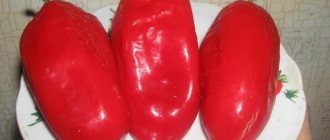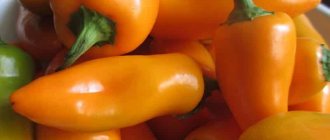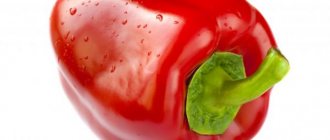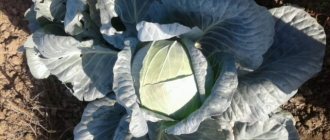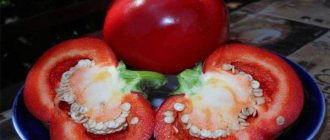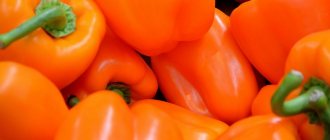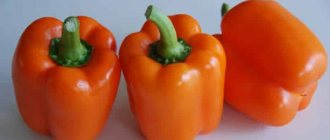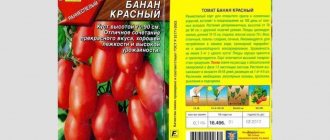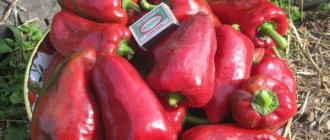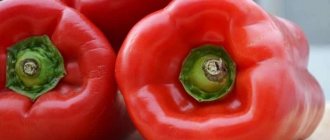Sweet pepper “Orange”, which got its name due to the brightness of the peel, which really resembles a tropical fruit, and also due to its high sugar content, can be used not only for salads, but also as a base for jam or other desserts. Thanks to these properties, it attracts the attention of gardeners who want to diversify their beds with a new crop.
This variety also differs from ordinary bell pepper in that it was created specifically for the central and northwestern regions. Therefore, Orange pepper is grown not only in greenhouses, but also in open ground, withstanding sudden environmental changes. According to reviews, the fruits can fully ripen even with short daylight hours. Such features are not surprising, because breeders from.
Agrotechnical characteristics of the variety
Pepper bushes grow compact and miniature, do not exceed 45 cm in height, which is why per 1 sq. m. grow up to 5 bushes without loss of yield. The variety belongs to mid-season plants, so the fruits fully ripen 90-100 days after planting the seeds. It is grown mainly using the seedling method, since if you plant seeds in open ground, this can affect the yield and germination.
Characteristics of ripe fruits:
- length up to 10 cm;
- wall thickness 4–5 mm;
- ripe fruit weight 40–50 g;
- the color of the peel varies from bright yellow to orange-red;
- sugar content reaches 6%.
Due to the fact that 30-35 pods can grow on one bush, from 1 sq. m. about 7.5-8 kg of pepper are collected. In greenhouses, this figure increases if the plant has enough nutrients in the soil. Despite the fact that this type is sweet, with a high sugar content, it has low energy value; 100 g contains only 26 kcal. Because of this, the fruits are an ideal treat for those who need dietary nutrition.
In addition, the variety does not cause allergic reactions, like other bright types of nightshades, so it can be eaten by pregnant and lactating women.
Important! Children really like these peppers, so it is necessary to ensure that a small child does not eat unripe fruits from the bushes.
Description of the variety
Sweet Orange peppers have medium-sized cone-shaped fruits. Their length is approximately 10 cm. The walls are 5 mm thick and have a thin glossy surface. The average weight of the cone-shaped fruits, rounded at the bottom, is about 40 g. One bush can produce a harvest of 25-35 peppers.
These fruits grow on neat compact bushes that do not grow very wide. This allows for dense, compact planting even in small beds. But at the same time, dense plantings of Orange sweet peppers will delight you with a good harvest if you care for them properly.
From 1 m2 you can remove 5-7 kg of wonderful fruits. If there is a greenhouse or hothouse, the yield will be significantly higher. The fruits are used stewed and baked, as a seasoning in soups and pilaf. And also - in various preparations: from lecho to vegetable caviar.
Pepper growing conditions and seed quality
In the middle zone and southern regions, pepper grows well in open ground and does not require additional insulation, but in the northern regions plastic greenhouses may be needed. And also when autumn comes, it is necessary to insulate the soil using a special film to prevent the roots of the plant from freezing due to sudden night frosts.
Even in greenhouse conditions, planting in the soil reduces germination by 1-2 times, and the plants turn out weak and sickly. In open ground, peppers germinate very poorly; due to the lack of heat and fertilizing necessary in the initial stages, the bushes grow too low. Their vegetative organs are weak, which slows down the formation of fruits. Due to late development and poor conduction of nutrients from the root to the shoots, the pods ripen more slowly and there is a possibility that they will have to be collected immature.
Advice! To obtain viable plants that will give a good harvest, it is necessary to use the seedling method.
Pepper Orange
Orange is not only a citrus fruit, but also the name of a variety of sweet bell peppers. The uniqueness of “exotic” vegetables lies not only in the name, but also in the amazing taste, which is comparable to a fruit delicacy. Orange pepper is distinguished by its special sweetness and aroma, which is why it is considered a delicacy. The variety is zoned for the central region of Russia and is available for cultivation to every gardener. A detailed description of the agrotechnical and taste characteristics of peppers of this unique variety is given below.
The Orange variety is represented by red and yellow peppers. The size of the fruit is small - each cylindrical vegetable is up to 10 cm long, its average weight is 40 g. The thickness of the pepper walls is small - up to 5 mm. The surface of the vegetable is smooth, glossy, the color is bright, the skin is especially thin and delicate. You can see the “Orange” pepper in the photo below:
Read also: Apple tree Bogatyr - description of the variety with photos, planting and care, reviews
The peculiarity of the Orange variety lies, first of all, in its unique taste and aroma. The pulp of the vegetable contains a large amount of sugar, vitamin C, carotene and other microelements, the complex of which allows us to consider the variety the most delicious, sweet and at the same time surprisingly healthy. The fruits are consumed fresh, and are also used for preparing culinary dishes and winter preparations. The absence of excess moisture in the pulp of the Orange pepper allows it to be dried in the form of small pieces, thereby obtaining tasty, sweet candied fruits - a healthy delicacy for adults and children.
Checking planting material
To get the right amount of seedlings, and in the future also bushes, you must first check how good the planting material is. To do this, shake the container in which the seeds are located, and select 3-5 pieces for testing. This method allows you to move grains between each other, which will give a more accurate result, preventing the selection of seeds extracted from only one fruit.
The control seeds are placed on a piece of dense soft cloth that has been generously moistened with water. The planting material is covered with its second end, after which the bundle is placed in a loosely closed container. After this, they put it in a dark, warm place, perhaps under a radiator. The main thing is that the temperature is uniformly high, but does not exceed 23-25 degrees.
Note! If the floors in the house are cold, then before placing a container on them, you need to lay a warm cloth or lay a wooden plank. This will eliminate distortion of the results due to freezing of the seeds.
If all testing rules have been followed, then after 4-5 days, most of the seeds should sprout in the container. If this does not happen, then the seed needs to be replaced. It is also important to remember that if the container was tightly closed, the grains could begin to rot. Therefore, a flow of fresh air is necessary to remove excess moisture, but it should not be very large, otherwise there will not be enough water for seed development.
It is advisable to check every day how wet the cloth is and whether it is dry. At the same time, you cannot lift it so as not to disturb the conditions for the seeds. If the material seems too dry, then water cannot be added by pouring, it must be sprayed. It is best to use a spray bottle for indoor plants for this; if you don’t have one, you need to wet your fingers and shake off the droplets of water. These methods of adding moisture will prevent both the seeds from drying out and being flooded with liquid, which can ruin the purity of the results.
Selection of seeds for planting
Before planting seeds in containers with soil, it is necessary to select those that will not sprout. These are sometimes called hollow due to the lack of nutrients necessary for the normal development of the embryo and sprout of the plant. Even if they hatch, in the future the bushes will be very weak due to disturbances in early development. Therefore, it is important to choose high-quality seeds.
To check you will need:
- 1 liter of boiled water;
- 30 g salt (about 1 heaped tablespoon);
- jar or deep bowl.
Pour water into the vessel and add salt, then mix thoroughly, waiting for it to completely dissolve. The liquid can be at room temperature, or a little warmer, it is important that it is not too cold or hot. After all the grains have disappeared, pour the seeds inside and make 3-6 circular movements with a spoon so that all the grains get wet.
Within 1-2 minutes, the seeds will separate into fractions, one of which will settle to the bottom, and the second will float to the surface. The latter must be carefully collected and thrown away, because it consists of seeds unsuitable for planting, and the one that has sank is washed with cool water and used for breeding seedlings.
Orange in a Russian garden
The variety was developed by domestic breeders on the basis of the experimental farm “Russian Garden”. The employees of this agricultural company take into account the peculiarities of growing southern crops in the central part of Russia and in the northwestern regions. Here it is not always possible to recreate the most optimal conditions for the heat-loving representative of the Solanaceae family. Therefore, the pepper varieties bred by the company’s employees are quite resistant to temperature changes, tolerate high air humidity, and also give a good harvest in conditions of short daylight hours.
This is confirmed by reviews of Orange pepper, which can be found on “garden forums”. They say that the variety has a bright, pleasant aroma, juicy and tender pulp, and an attractive appearance. In addition, reviews of Orange sweet peppers are simply full of information that the variety is unusually productive. Up to 35 peppers ripen on one bush.
Growing seedlings
First you need to determine the time of planting the seeds in the soil. To do this, you need to know where they will grow; if outdoors, it is recommended to plant them from February 20 to March 10. This time is optimal for the middle zone, so that the ambient temperature at the time of planting is above 13 degrees. It is best to propagate seedlings in February, so that there is time to plant a second batch if some of the seeds do not sprout. For greenhouses, grains are laid earlier, due to the fact that the desired temperature appears in them faster.
Advice! In order for the seedlings to grow well, the seeds must be germinated before placing them in cups. This is done in the same way as testing for germination.
When seedlings are grown at home, it is best to purchase soil in special stores, because homemade soil will smell quite unpleasant. But if you are planning a separate room, then you can make the soil for the seeds yourself.
Optimal soil for seedlings:
- 2 parts peat;
- 2 parts of humus obtained from leaves;
- 1 part of ordinary land.
The soil is placed in peat or thin plastic cups. A 5 mm hole is formed in the middle, into which 1 germinated seed is placed. The hole is covered with soil. The main thing is not to compact the soil, otherwise the seeds will not be able to break through it. The containers are covered with film or transparent plastic and placed in a warm place.
All shoots should appear at about the same time, and you need to carefully monitor the cups. When this happens, remove the lid and place the seedlings in a well-lit place. If there is no such thing in the house, then it is necessary to support the plants with the help of special lamps.
Growing technique "Orange" variety
Since the variety is heat-loving, it can be grown exclusively by seedlings, and even after planting the seedlings, it should be protected for some time with a film cover, which should not be removed at all in cold weather. Agricultural technology for growing the variety includes the following measures:
- Preparing seeds for planting.
- Preparing the soil mixture.
- Planting seeds for seedlings and caring for them.
- Planting in open ground.
- Caring for seedlings.
Seed preparation
Typically, if you purchase ready-made seeds from a manufacturer, they are already calibrated and processed before being packaged for sale. If the seeds are selected independently, first of all they should be calibrated (selected). To do this, prepare a solution of 1 tbsp. spoons per 1 liter of warm water. Seeds are thrown into it. Empty seeds that do not have a sprout will float - they are selected, and sunken seeds are suitable for cultivation.
The seeds should also be pickled. The most popular method without the use of chemicals is bubbling. To do this, the seeds are immersed in warm water and treated with air bubbles during the day. The bubbles are generated by the aquarium compressor. A more standard etching method is treatment with a 2% solution of potassium permanganate. Instead, you can use fungicides Agat, Apron. To do this, the seeds are placed in a bag made of light fabric and immersed for 20 minutes in a solution of potassium permanganate or fungicide.
Important! If the seeds sprouted during bubbling, the procedure is stopped and the seeds are planted.
In order for the seedlings to be strong and more resistant to disease, they should be treated in a solution of Epin-Extra, Ideal or another growth stimulant. A solution of 20 g of ash per 1 liter of water is suitable for this purpose. The treatment should be carried out by immersing the seeds in the solution for up to 5 hours.
Soil preparation
For orange peppers, you should prepare the following mixture: 1 part peat, 2 parts humus and 1 part turf. Add 1-2 cups of ash to this mixture and mix. After this, the resulting soil must be etched. Treatment with a 2% solution of potassium permanganate (spray) is well suited for this. Also, the soil can be kept in the cold in a bag for 1.5 months, or calcined in the oven at a temperature of no more than 100 ºС. Instead of calcination, exposure to high temperature in a steam bath for 30 minutes is suitable.
Any container is suitable as a container for seedlings - a box (if the seeds are planted together) or individual pots, in which you must make a hole at the bottom.
Planting seeds for seedlings and caring for them
Since seedlings are planted 40-50 days after planting the seeds, they are planted in the first half of March. The prepared soil mixture should be shed with warm water. Pepper seeds are planted in the ground to a depth of no more than 1 cm. After planting, the container with the seeds should be covered with film. Since pepper of this variety is light-loving and requires at least 12 hours of daylight, it is extended by placing fluorescent lamps along the borders of the area with seedlings.
Important! As soon as the first sprouts appear, the film should be removed, otherwise the sprouts will quickly grow in length, be thin and quickly bend, making such seedlings unsuitable.
12 days after planting the seedlings, fertilizing should be done, which should be repeated once every two weeks. A solution of fertilizers containing nitrogen, phosphorus, and potassium is suitable as a top dressing. The soil for seedlings should be periodically moistened by spraying with warm water.
Planting in open ground
10-12 days before planting in open ground, seedlings begin to harden. To do this, it is taken out into the open air, starting from 30 minutes to staying outside for a full day. Without this, the seedlings will be sick after planting. You should start hardening only during the day, when the air is already warm!
Seedlings are planted according to the 40-50 cm pattern (about 5 bushes should be produced per 1 sq.m.). The holes are fertilized with a mixture of humus, turf and sand mixed with 0.5 cups of ash. During the first 12 days after planting, the seedlings may be sick, so they should be loosened and not watered unless the soil is too dry.
Important! Seedlings of the "Orange" variety need to be pinched by cutting off the top of the main stem. This stimulates the formation of lateral stems, the number of which should not exceed 5. Excess, weaker shoots need to be removed.
Seedling care
After planting in open ground, the seedlings need to be covered with a shelter made of metal arcs and film. In cool weather, the shelter does not need to be removed at all, only lifting its edges for ventilation or removing it for loosening, weeding and fertilizing. The bushes should be tied up, as the fruits grow profusely and can break the stems. Fertilizing is carried out during flowering and fruiting with solutions of fertilizers, including nitrogen, potassium, phosphorus, or instead use infusions of mullein and bird droppings. Watering should be done 2-3 times a week at the rate of 10 liters of water per 1 square meter. m. For irrigation, it is better to use warm water, having previously heated it in a barrel under the sun.
Thus, the “Orange” sweet pepper variety will be an excellent solution for growing by professional farmers and amateur gardeners. Despite the small size of the fruits, the variety maintains yield indicators on par with giant varieties, and its original appearance and color give it an undoubted advantage over other varieties of pepper.
Transferring seedlings to the ground and caring for plants
According to reviews from people who constantly grow Orange peppers, it is optimal to plant seedlings when they are about 50 days old. But it must be remembered that at a temperature of 13 degrees, all types of peppers stop growing, so the night temperature should not fall below 14 degrees. Otherwise, the seedlings may go dormant or die altogether. But these temperatures are designed for hardened shoots, so 2 weeks before transferring them, it is necessary that the trays with plants be outdoors. You can start with 1 hour in the middle of the day, gradually increasing the time.
The seedlings are planted in a garden bed, the distance between the bushes should be at least 30 cm, and preferably 40-45 cm. The plant should not be taken out of the container by pulling the stem, or by digging it up. Therefore, the plastic container is carefully cut and removed, and the peat container is buried along with the rhizome.
When the plant has taken root, it is tied up and the main stem is pinched. As it grows, it is necessary to monitor the number of lateral branches on which the fruits are formed. According to reviews from summer residents, the plant can normally withstand no more than 5 branches, otherwise the number of peppers will decrease and the fruits themselves will become smaller.
Sweet orange peppers are a good choice for those who like sweets, but do not want to get extra calories. And due to the fact that it was bred specifically for the central regions, the plant does not require special care, only minor fertilizing with manure diluted in water. Therefore, it is an ideal variety for beginning gardeners.
Features of cultivation and care
It is recommended to sow Orange seedlings from February 20 to March 10. It is better to plant 1-2 seeds at once in separate containers.
Seedlings are moved to a permanent location in the ground at the age of 60-70 days, after the threat of return frosts has passed.
The Orange pepper variety, like other representatives of this variety of nightshades, loves loose, fertile and non-acidified soils.
Caring for the crop comes down to regular watering every 3-4 days during hot summers, loosening and weeding the beds or mulching them.
Pepper loves feeding at all stages of development. During the period of growing green mass, plants especially need phosphorus and nitrogen; at the time of fruit set, they need potassium.
Since the Orange bushes are quite tall, they may require staking. To increase yield, it is recommended to remove the crown flower and all side shoots before the first fork. All stepchildren located above must be left behind. Pruning is carried out throughout the entire growing season as the shoots grow.


